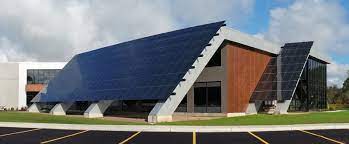Riverview Solar Technology Park—Powered by Sun, Powered by Green
- Discover 716

- Oct 25, 2021
- 4 min read
Updated: Oct 27, 2021
By Jianqi Zhou
You may not realize that we receive an amazingly massive amount of energy from the sun every second. Let me show you the math. The sun produces 3.8x10^26J of energy every second while the global annual energy demand is about 5.8x10^20 J. If we could capture all the energy from the sun in that one second, it could provide enough energy for our planet for 655,000 years. However, collecting and converting this energy into utilizable energy is way more complicated than we thought. After subtracting the energy loss due to the curvature of the earth and the density of the luminosity, only about 0.000000056% of the energy we receive from the sun. But even with this tiny portion of the solar energy, it can power ten of our Earths today. So, how can we convert it into the energy forms that we can use? And how much of them are is utilizing in our life? What are the challenges we may meet during energy exploitation?

As we know, sunlight can provide us with direct and basic functions of heating, illumination, disinfection. Indirectly, we consume solar energy through plants and meats as well. As our society and technology develop rapidly, the basic application of solar energy is not enough to sustain and our modern lifestyle and energy demand. Thus, many technologies were emerged for the exploitation of solar energy, like photovoltaics (PV), solar-heat concentration, solar hydrogen, etc. The most widely adopted one in the United States is PV. I believe many of you may have already installed or be thinking about having one or more PV panels on your house. Trust me, you made a great decision. You essentially have an electricity generator for your own with the PVs. From the environmental perspective, you decreased your demand for fossil fuel and lowered your carbon footprint, also facilitated the development of renewable energy. On the other hand, the alternative supply can not only help you to save some on your electricity bill but also can serve as a backup energy source during some unexpected circumstances, like power outages, hurricanes, and so on. Especially, right now, the government has a lot of incentives and rebate programs. It would be a heavily leveraged and sustainable investment for you, the society, and our environment.

The working principle of a solar panel is that the particles of light, also called photons knock the electrons free from atoms, and generate a flow of electricity under the drive of voltage. This process is also called photovoltaics which means converting solar energy into electricity. However, it is not a 100% energy conversation. The efficiency of a solar panel depends on many inner and outer factors, such as the incident angle of the sunlight, temperature, light density, conductivity of the composed materials, and so on. In other words, solar energy conversion always comes with energy loss. According to the U.S Energy Information Administration (EIA), the average efficiency of a commercial solar panel is about 15% to 20% today. The most efficient one, the experimental PVs on the space satellites, is about 50%. Thus, advanced technologies are still needed to minimize the loss during energy conversion. Besides these theoretical and technical issues, one of the main barriers to solar energy utilization could be the market state. Fortunately, with governmental support and dissemination, the price of PV dropped a lot. Also, the percentage of electricity generation from solar energy had jumped from 11 % to 39% since 2017 in the U. S. But still, compared to the price of fossil-generated electricity, many people would like to pay for the stable low electricity cost rather than putting the investment in the beginning and waiting for the payback time.

WNY may not be the best geographical and climate-suitable location for PVs, but Montante Group is very confident that solar energy will boost their customers’ business more profitable and environmental-friendly. Their Riverview Solar Technology Park, New York’s first solar-ready business park, is a place where real estate development and solar project development blend seamlessly in a picturesque setting overlooking the Niagara River. The 200-acre business park offers both existing commercial space and shovel-ready land for new construction. The Park also acts as a living solar lab, where the future of solar technology is tested and implemented to improve energy efficiency and energy production. Based on the evaluation from the EnergySage website, the Riverview Solar Technology Park’s average annual energy savings is about $20,000. This means the solar panels help the Park to save up to 25% more electricity than conventional energy supply. Montante Group not only helps their tenants to save electricity bills but also mitigates the energy demand stress of the National Grid. Currently, the Riverview Solar Technology Park has embraced many clean energy lovers, which include Mohawk, CSX Transportation, Johnson Controls, Pine pharmaceuticals, etc. Last year, Amazon also opened a new delivery station in Riverview Solar Technology Park. More information about Riverview Solar Technology Park? Visit https://www.riverviewsolarpark.com
How do you think about solar energy application in WNY? Please let your comments below.







Comments